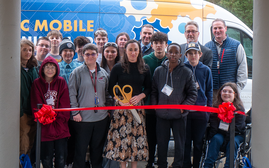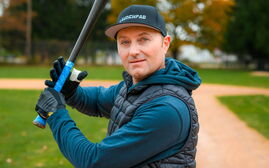New Mainers get EMT training at SMCC
There are more than 5,600 emergency medical service providers licensed in Maine, according to Maine Emergency Medical Service’s 2016 annual report. The average age is 40.4 years, with 50% being 45 years or older.
Like Maine, the demographics of the state’s emergency providers highlights an emerging workforce problem requiring younger trained emergency medical technicians to replace the providers who will be retiring.
A new program at Southern Maine Community College is doing just that, specifically targeting new Mainers seeking entry-level healthcare jobs. Mainebiz sat in on a recent class.
"I'm sending you out to do primary triage," Eric Wellman tells his class at Southern Maine Community College.
This morning there are about eight students, from several different countries, learning how to become emergency medical technicians (EMTs). The program was launched in January for new Mainers after Scarborough-based North East Mobile Health Services expressed a need for more trained EMTs. SMCC, which offers an associate degree in emergency medical services, launched the course with funding from the Maine Quality Centers and the John T. Gorman Foundation. It includes an English learning component.
"Their vocabulary is actually superb when it comes to medical terminology," says Wellman, a trained paramedic who chairs SMCC's emergency medical services department.
Today's mass-casualty simulation centers on a natural-gas boiler explosion at a local business, with as many as 15 people inside at the time including children.
Like a dispatcher on the scene, Wellman gives students 10 minutes to find as many patients as possible and triage them according to what they just learned. Instead of tagging people with red, green, yellow, or, in the case of death, black, they are given a scorecard to record information on each patient.
Patients are not real people, but numbered sheets of paper randomly scattered throughout the building list their symptoms. Most students return to class having found all 19, some beyond the allotted 10 minutes. Wellman does a rundown of each patient and treatment: No. 2, no sign of life (black tag, "If that's not dead, I don't know what is"); No. 3, walking but bleeding (green tag, first responders move on; No. 6, screaming child, alert and walking (green) and No. 8, can't walk, respiratory problems (red tag for immediate treatment).
In real life, Wellman says, first responders would have limited time and resources, even when it comes to finding ambulances.
"This is, at best, organized chaos," he tells them. "It's much like herding cats."
He also notes that "a lot of rules get broken" during an initial triage.
His words don't seem to rattle students, many of whom have a medical background but may not have the necessary certifications to do similar work in the United States. Most are there to improve their English while working in a familiar field.
"This is our profession, so that makes it easier," says Pamela Nyota, a refugee from the Democratic Republic of the Congo, where she was a nurse.
Compatriot Cedrick Wa Bisembo, who had been a surgeon, has a long-term goal of becoming an epidemiologist. "I have first to improve my language skills," he says.
After the class wraps up in October, students will have up to a year to sit for their EMT registry exam, and those that pass will then get to interview with NEMS, whose CEO Butch Russell says he has 20 openings.
“We’re very glad to be able to offer all of them interviews,” he says. “The added benefit of most of them being bilingual adds to their value as employees.”













Comments